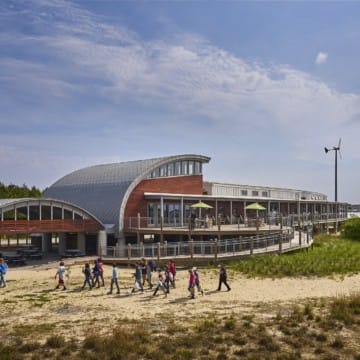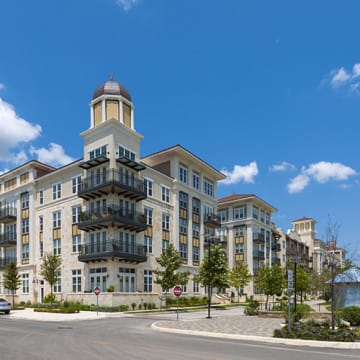The Waller Creek District and Tunnel
Austin lies in the heart of Texas’s “Flash Flood Alley,” where flash floods have led to significant property damage and loss of life. To reduce the risk of flooding in its downtown, the City of Austin developed the mile-long, underground Waller Creek Tunnel, which captures excess rainwater upstream of Waterloo Park and redirects it to Lady Bird Lake. The Waller Creek Tunnel removed more than 28 acres of downtown from the floodplain, providing opportunities for redevelopment. The tunnel also reduces Waller Creek bank erosion during flood events and gently pumps lake water back into the creek to keep it flowing during dry times.
Redevelopment of the district surrounding Waller Creek has been catalyzed by development of the tunnel and Waterloo Park, an 11-acre green space in downtown Austin that hosts an array of public amenities, including the Moody Amphitheater and a connection to the 1.5-mile Waterloo Greenway trail system. Redevelopment of the park and greenway has been made possible through a public/private partnership between the City of Austin and Waterloo Greenway Conservancy, as well as funding from tax increment financing (TIF), implemented in Texas through Tax Increment Reinvestment Zones (TIRZs).
Context
Austin’s Waller Creek Tunnel, completed in 2017, captures floodwater and releases it into Lady Bird Lake, reducing the size of the floodplain along lower Waller Creek and helping revitalize the eastern part of downtown Austin, called the Waller Creek District. The tunnel is about 5,600 feet long, lies 70 feet below the surface, and ranges in diameter from 22 to 26 feet.
Construction of the tunnel has enabled businesses, governments, and nonprofits to invest in the Waller Creek District. The City of Austin, the Waterloo Greenway Conservancy, and the Waller Creek Local Government Corporation created a vision for the district to guide that investment. A mix of private and public projects is in the works for the district, including 35 acres of parks and open space.
The Waller Creek Tunnel was funded through tax increment financing (TIF). The Waller Creek TIF only uses funds generated by the increased property values and property taxes in the Waller Creek District. The TIF not only paid for the tunnel, but also helped fund the redevelopment of Waterloo Park. The Waterloo Greenway Conservancy, the TIF, and the City of Austin are also funding a chain of parks and trails along the creek, called Waterloo Greenway.
Since opening in August 2021, Waterloo Park has welcomed tens of thousands of visitors to explore nature, gather with friends and family, and immerse themselves in musical, cultural, and performing arts experiences. The park includes the new Moody Amphitheater, a 5,000-person outdoor concert venue; an 11-acre green space with a native plant garden; a constructed wetland and terrace next to Waller Creek; walking and biking trails with a skywalk, traditional and nature playscapes; and dedicated space for local food trucks. Waterloo Greenway Conservancy offers free weekly community programs and year-round special events at the park, providing an accessible space where Austinites can relax, have fun, and connect with one another.
Reinvestment along Waterloo Greenway is focused on transforming lower Waller Creek from the site of eroded, polluted, and flood-prone channelized infrastructure into a natural oasis for both humans and habitats. With the addition of the tunnel, the creek conveys less stormwater, allowing it to look and feel more like a natural stream system and take on a new role in downtown Austin. The Waller Creek project invests in public open space, trails, and ecosystem rehabilitation, enhancing access to nature and health in downtown Austin and enabling future resilient development.
Resilience Strategies
- Stormwater management. The addition of the Waller Creek Tunnel removed more than 28 acres of downtown Austin from the floodplain, providing opportunities for redevelopment in the Waller Creek District. The tunnel also reduces Waller Creek bank erosion during periods of flooding and gently pumps lake water back into the creek to keep it flowing during dry times.
- Green infrastructure. Investment in green space and ecosystem restoration along the Waterloo Greenway helps manage stormwater and flooding, rebuild ecosystems, and enhance access to nature and health for Austinites. The addition of green infrastructure also helps mitigate the urban heat island effect and improve air and water quality.
- Native plants. To create an ecologically robust riparian corridor, the Waterloo Greenway Conservancy has focused on saving and adding native plants to the greenway. In Waterloo Park alone, 95 percent of the 90,500 plants and trees are native and 5 percent are adaptive. In the next phase of redevelopment, the conservancy plans to add about 200,000 native plants and 1,500 trees along the greenway from Fourth Street to Lady Bird Lake. The focus on native plants supports local habitats and pollinators, ecological diversity, ecosystem restoration, and resilience to heat, drought, and flooding.
- Water reuse. Waterloo Park uses Austin’s reclaimed water instead of potable water for subsurface drip irrigation and toilet flushing, allowing water and energy conservation and drought resilience. The park also has a 50,000-gallon cistern to capture rainwater for reuse.
Value Proposition
- Added amenities. The addition of the Waller Creek Tunnel and redevelopment of the 1.5-mile Waterloo Greenway, including Waterloo Park, have added significant value to downtown Austin. Waterloo Park’s new amenities—Moody Amphitheater, an 11-acre green space, walking and biking trails, playscapes, and programming—provide an accessible space for Austinites to relax and have fun.
- Avoided losses. The Waller Creek Tunnel significantly reduces flood risk between 12th Street and Lady Bird Lake. Previously, flooding and erosion along Waller Creek were regular occurrences.
- Reduced insurance premiums and improved insurance ratings. The Federal Emergency Management Agency (FEMA) floodplain map of the area was updated in 2022 to reflect the improvements. With reduced flood risk, properties in the Waller Creek District are expected to see reduced insurance premiums and improved insurance ratings. Lenders may still require flood insurance, however, and businesses and residents may also choose to keep their flood insurance for financial protection.
- Increased developable land. The Waller Creek Tunnel removed more than 28 acres of downtown Austin from the floodplain, providing opportunities for redevelopment in the Waller Creek District.
- Capital attraction. Because of the tunnel, businesses, governments, and nonprofits are now able to invest in the Waller Creek District. A mix of private and public projects is in the works for the district, including billions of dollars in private development.
- Enhanced property value. Reduced flood risk and high-quality amenities will lead to enhanced property values in and around the Waller Creek District. The investments in the area are expected to increase downtown tax revenue.
- Water savings. Waterloo Park’s use of reclaimed water and rainwater instead of potable water for subsurface drip irrigation of the 11-acre green space will result in significant water, energy, and cost savings.
- Awards and recognition. Waterloo Park received the ULI Austin Impact Award for Best Public Place in 2022 and the Waterloo Greenway received the ULI Austin Impact Award for Next Big Idea in 2019. Moody Amphitheater achieved four stars in the Austin Energy Green Building rating system in 2021.
Lessons Learned
Vision and planning
The City of Austin and Waterloo Greenway Conservancy staff note that having an exciting and engaging vision upfront was vital to get people on board with the long-term project. “You really have to think about the full life cycle upfront when you’re starting a project like this,” said Kristin Pipkin, project management supervisor for the Waller Creek District Program in Austin’s Watershed Protection department.
This project started with a framework plan that served as a proof of concept for the Austin City Council. Once that plan was approved, the city held a national design competition in 2012, which led to the selection of a design plan that was amended in 2018 and is now referenced in the city’s comprehensive plan.
Within the partnership, planning was essential to figure out the phases of construction, budget timelines, scopes of work, and how to work together across organizations and departments.
Public/private partnership
“It takes a village to make a project of this size and complexity happen,” Pipkin said. While the city was responsible for the tunnel project, partnering with a separate organization responsible for the Waterloo Greenway over time as well as fundraising for capital improvements proved important for the success of the multi-tiered project.
Waterloo Greenway Conservancy was created for this purpose in 2010 to respond to citizens advocating for park and trail redevelopment along Waller Creek. In 2014, the partnership was formalized by a joint development agreement. The convervancy and city recommend engaging in a partnership agreement upfront so that each organization knows what it is responsible for and how best to work together. They also recommend allowing for adaptability, flexibility, and contingencies.
In the case of this partnership, the city is responsible for the Waller Creek Tunnel and owns the land, watershed, and public improvements. The Waterloo Greenway Conservancy is an independent nonprofit responsible for fundraising, design, construction, programming, operations, and maintenance for the Waterloo Greenway. The Waller Creek Local Government Corporation is the approval body for contracts, budgets, financing, design, construction, operations, and maintenance, and is given authority for oversight of the district by the city council.
Political and financial champions
It was clear from the beginning that to develop a project of this scale, it was necessary to have champions with standing and respect in the community who could pull political weight. Leadership from the city was important for the cross-department collaborations, but champions from the community were needed to justify the time and costs of the project. Having a grand vision and plan was helpful for getting community buy-in and sustained interest.
The redevelopment intersected with various interrelated issues, such as infrastructure, private development, utilities, building codes, transportation, affordability, growth, resilience, history, accessibility, and safety. These issues attracted more interested parties and required upfront, transparent communication about what was happening with the project. As an example, the city is working with developers on voluntary design guidelines within Waller Creek District that support Waller Creek. Ongoing communication efforts include public relations, partnerships, signage, programming, and public art.
Sustainable funding sources
With a project of this magnitude, significant and sustained funding mechanisms are required. The Waller Creek Tunnel was a $163 million TIF investment. Redevelopment of the 1.5-mile Waterloo Greenway, including Waterloo Park, is estimated to cost around $265 million over three phases and will be covered by TIF, funds from the U.S. Army Corps of Engineers, park bonds, drainage utility fees, development fees, city budgets, and private partner fundraising. Once the greenway is redeveloped, Waterloo Greenway Conservancy will be responsible for operations and maintenance, which will be covered by programming and concert revenue, philanthropy, and a partnership with the Austin Downtown Alliance business improvement district.
The project partners recommend determining upfront the financial mechanisms—such as TIF, improvement districts, taxes, fees, and/or community partnerships—and building them into the project from the beginning. So far, the selected financial tools are working for the Waterloo Greenway.
ULI is grateful for the support of The JPB Foundation.


